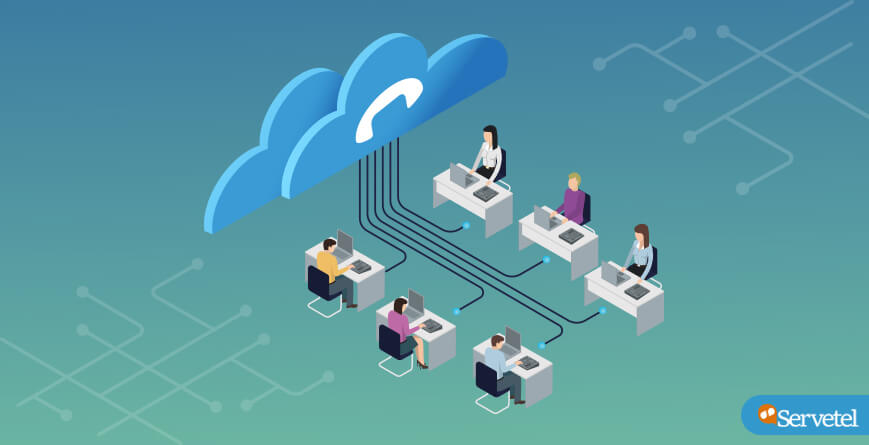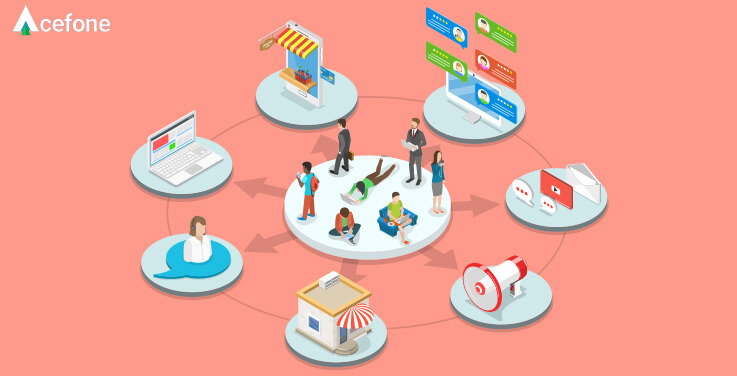The advancement of technology has brought upon a substantial change in how businesses operate. The technology of today will be obsolete next year and this advancement is only pacing up. The only common thing today and 10 years before in an office is the telephone. So is the telephone the ultimate invention? In its true essence, this is not so true. The underlying architecture of the telephone has changed to an unrecognizable extent.
The rise of the cloud has brought upon the ultimate communication revolution and consequently given rise to what we today know as cloud telephony. Cloud phone system providers are changing the ‘Enterprise Voice’ as we know it and bringing a complete unification and automation of the telephony paradigms such as voicemails, call forwarding, call and message based campaigns, customer interaction and call routing.
If this isn’t enough, cloud telephony has enabled the integration of data and records from various sources and even goes on to automate data management. So let’s look at what led to the rise of cloud telephony in the enterprise environment and how it is transforming the enterprise functionality.
How is cloud telephony different and what makes it better?
On-premise telephony systems require setting up of the whole infrastructure at one location. Now, this does give one complete control of the telephony systems but it comes with its drawbacks. Because these are traditional landline systems, they require high maintenance and are affected by weather conditions. As such they are also susceptible to damages that may occur due to a variety of reasons.
Cloud telephony systems are based out of the cloud and as such these do not require any hardware or infrastructure except for the telephones themselves. Also, being hosted over the cloud these are not much inflected by any change in environmental conditions or susceptible to damages per se. Yes, one may feel that it gives them less control of the infrastructure but it also takes away the responsibility setting up and maintaining the infrastructure.
In this regard, the amount of time, money and manpower saved is substantial enough to negate what one might consider as less control. And in reality, one gets as much control as an on-premise system and more.
When comparing traditional and cloud telephony systems, the scalability of the later is found much higher. An organization can meet its demand fluctuation with a mere call. They can scale up or down whenever they want and hence only pay for what is required. On the other hand, a traditional system can only be upscaled (at the intensive cost of expensive investment in hardware and manpower).
The Rise of UC&C
With the cloud in play, a new method of transmitting voice and multimedia took place. To understand this better let’s see what happens at traditional 2G and 3G based networks.
When a phone call is placed a link is set up between the caller and the recipient. A particular bandwidth is allocated to this link and the call takes place via the link. The link exists as long as the call is connected. A fairly simple method and a reliable one, this method is known as the Circuit Switching method.
With the advent of the cloud, the idea of transmitting voice and multimedia over the internet took birth. This gave birth to the IP technology or Voice over Internet Protocol (VoIP). With VoIP, there is no need to reserve any bandwidth for any call. Instead, the data is segmented into various packets. The packets are transmitted individually and hence the bandwidth can be allocated to multiple users.
But this is easier said than done. Because multiple users send various packets via a shared line there is a possibility of some packets arriving late and some getting lost in transmission. This poses a serious problem in voice-based communication as parts of words, complete words, or even complete sentences may be lost, making any conversation meaningless.
With the advancement in technology, a lot of improvements have been made in the packet-switched network, and they are more reliable today than ever.
Quality or Cost? The big debate:
While using VoIP enterprises got the ability to use just their broadband networks to make calls, thereby making business easy and affordable. An organization could cover multiple geographical locations without the need for an on-premise system to be established at all locations.
But the drawback of unreliability was still too much for many organizations to accept VoIP Phone Service and hence the choice between VoIP Phone System and Traditional Systems became the choice between Cost and Quality.
This was settled with the advent of 4G LTE. LTE stands for Long-Term Evolution and has greatly enhanced the internet speed. Compared to 3G, 4G LTE is at least 10 times faster. 4G LTE uses the following two technologies for voice calls:
CSFB (Circuit-Switched Fall Back): CSFB came as a simple solution that data shall be transferred over LTE network whereas when a call is made, the LTE network simply latches to a 3G or 2G network and hence avoid any latency issues in voice conversations.
VoLTE (Voice over LTE): Much like VoIP, VoLTE uses packet switching to make voice calls but the network provider invests heavily in the underlying network infrastructure to avoid any latency issues. Also, since LTE is at least 10 times faster than the 3G, the latency reduction is exponentially better.
VoLTE did not just mark the end of the big debate, but also provided the stepping stones for the rise of UC&C: Unified Communications and Collaborations. It is the unification of multiple enterprise communication tools. In simpler words, all of an enterprise’s e-mails, voicemails, voice communications, web, messaging, real-time communications and conferences along with schedules and dates can be integrated into one system capable of managing all of this.
Cloud Telephony is More Than Just a Telephony Service
The real success of cloud telephony is because it has become more than just a telephony service. For any enterprise, business generation is irrefutably the most prominent factor in determining their success. As such the goal of every enterprise is to focus on how to make their operations smooth.
Here is how cloud telephony has changed that:
Remote Control:
With the advent of cloud telephony it possible to monitor and control the sales team, processes and strategies remotely from any corner of the world. Cloud telephony service providers also include a supervisor panel which enables one to monitor all activities in real-time. This comes with options such as listening to a call, whispering to the agent so that only the agent hears what the supervisor says and the client don’t, and taking over a call, which allows a supervisor to take over an ongoing call shall they find the need to do so.
All that is required is an internet connection. Complete control served remotely!
Real-Time Analysis and Updation:
A big hassle with enterprises is the continuous flow of heavy data coming from multiple sources. Managing the database in real-time takes a lot of effort and manpower. With cloud telephony services, not just the data coming from various sources but that acquired from the calls can be integrated with the database in real-time.
Also, because it is linked with the cloud and the integration of cloud-based AI has made database management an automated process there is no manpower invested.
Unmatched Scalability:
Unlike traditional PBX systems, cloud telephony does not require any setting up of hardware infrastructure. A simple call is sufficient to scale to match the requirement.
Also, this scalability is not permanent, shall the requirements reduce one can relatively downscale. One only pays for what is utilized without compromising on the business requirements.
Smart Lead Generation:
Generating leads is an important task for all businesses. What’s more important is the conversion rate of the leads so generated. With cloud-based telephony, one can monitor all leads from multiple telephony services simultaneously to determine which leads will be best converted.
This, when backed with AI, can be done without any human intervention and with more accuracy. On the other hand with the traditional telephony system, this is an immensely difficult task.
All campaigns at a single dashboard:
An enterprise uses multiple campaigns for various purposes. These may include awareness campaigns, press 1 campaign, voice broadcastings and may more. With cloud telephony, all these campaigns can be easily managed from a single dashboard.
Their outputs can be easily integrated automatically in real-time with the database. The agents, therefore, are always aware of what the current scenario of a particular campaign is. Shall a campaign not be required anymore or it may not be producing results, it can be terminated right away.
The Introduction of BYOD methodology:
Because all that is required with cloud telephony is an internet connection, it has given rise to Bring Your Own Device methodology in the enterprise realm. There is no longer the need to provide a device to each individual. Individuals can bring their own devices and work with those.
The host provides the services over the cloud, and consequently, these can be availed on any device. Most employees prefer using their own systems that they are comfortable with hence, the flexible working policy or the BYOD is becoming more coming as time progresses.
True Automation:
The enterprise world is moving towards automation. It is no longer the future of enterprise but the very present of it and for good reasons. Automated systems are error-free and more efficient than human agents. But true automation cannot be achieved without cloud telephony.
It is not possible to update real-time data of all campaigns with a traditional telephony system. With cloud-based telephony not only can one remain updated at all times but an organization can integrate features such as virtual agents and chatbots. Virtual agents are meant to be the future of business-customer interaction.
This simply isn’t possible without cloud-based telephony.
No Downtime:
With cloud telephony, the service provider manages all the underlying functionality. Also unlike traditional systems cloud telephony system suffer little to no downtime. As a matter of fact, cloud telephony boasts of 99.9% uptime which ensures that all of your opportunities are attended to.
Reduced Expenses:
A major part of an organizational expenditure is in office space and hardware. It is well-established how an organization can reduce infrastructure costs as no on-premise infrastructure is needed. It also noteworthy that an organization can outrightly reduce its office space expenditure to zero by going remote!
As cloud telephony is based out of the internet there is no need to have agents work from an office space. Agents can work from their homes as well and having a supervisory account enables the organization to track the performance of each agent in real-time.
Also, the fact that cloud telephony is capable of routing calls to agents based on availability, department, and preferability (a customer who has previously been dealt by a particular agent is likely to get the same agent if the agent is available) adds to improving performance and reducing call time.
Therefore an organization never has to struggle with a remote agent. Organizations also have access to a detailed performance sheet of every agent and can therefore easily administer their incentives and promotion policies.
Synopsis
In light of the above illustrations, it is evident as to why cloud-based telephony stands where it stands today. It is an imminent component for organizations of this age that want to keep up with the pace of technological advancements. Cloud telephony holds equal significance to enterprises of all levels.
While startups need cost reduction, large enterprises need the ability to manage all geographical locations. However, all enterprises need integrability with advancing technologies such as Artificial Intelligence, Virtual Agents, Chatbots, Automated data management systems, client behavior analysis, real-time updation and analysis, Cloud and Hybrid Computation, et al., irrespective of their size or span.
This could not but be achieved without telephony being available via the cloud. Hence this era has marked the rising of the cloud phone service in the enterprise environment at a pace much faster than imagined. And much like every technology of yesteryear, the traditional PBX is going to become obsolete sooner than later.














